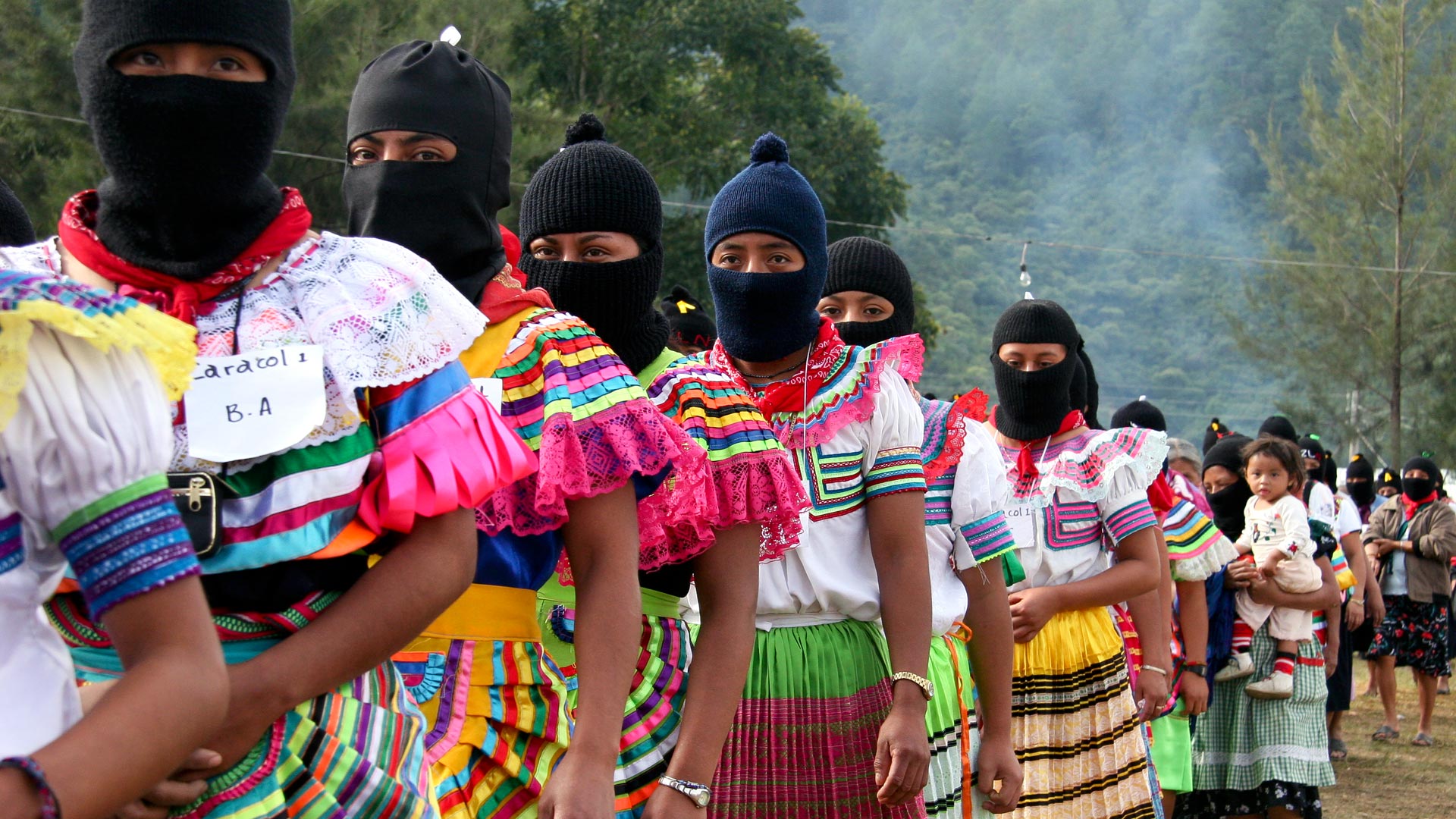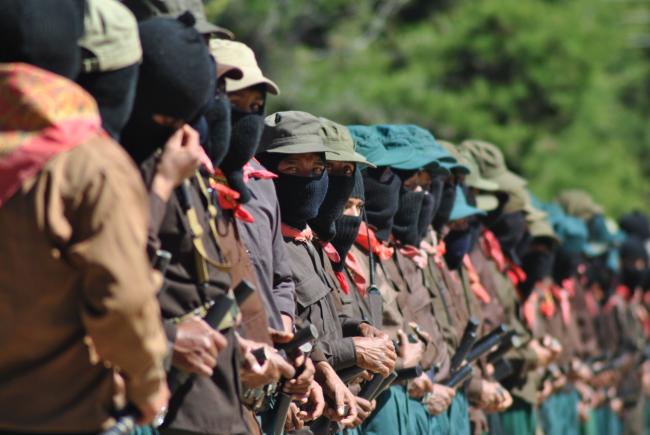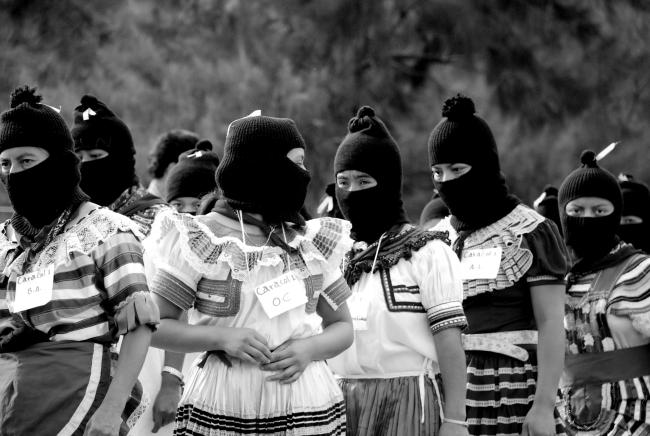Written by Raúl Zibechi
The uprising of the Zapatista Army of National Liberation (EZLN) 30 years ago managed to put autonomy at the top of the agenda of some social movements in Latin America. Until that time, in most Latin American countries, there was not a political and cultural current oriented in that direction, as there is today. At most, there were autonomist positions inspired by Italian “workerism” (operaismo) that gave rise to European “autonomism.” This current, which took shape in the work of Italian philosophers Antonio Negri and Mario Tronti, never held real weight in Latin American struggles and movements, and its influence was concentrated in universities and among Marxist intellectuals.
The EZLN was formed in 1983 in Indigenous regions of Chiapas. For 10 years, the movement took root among the pueblos, and after extensive consultation with some 500 communities, they decided to declare war. That war took shape in the uprising of January 1, 1994, the same day that Mexico entered the North American Free Trade Agreement (NAFTA). The war lasted less than two weeks as civil society mobilized to demand peace, and a period of dialogue began between the government and the EZLN.
Zapatismo not only placed the debate on autonomy at the center of its political thought and practice—an issue that was on display in the 1996 San Andrés Accords negotiated with the Mexican government. It also demonstrated the leading role of Indigenous peoples, who are the most prominent subjects of the fight for autonomy.
International meetings played an important role in the dissemination of the EZLN’s thinking, as did the countless communiqués in which then Subcomandante Insurgente Marcos recounted scenes of life in the communities and about the movement’s militants. The Intercontinental Encounter for Humanity, held in La Realidad in 1995, welcomed hundreds of people from all over the world, with a large presence of European libertarian and autonomist youth groups.
The fact that Zapatismo appealed to diverse groups in society—especially rebellious urban youth (gay, lesbian, precarious, and unemployed)—and did not use traditional leftist concepts such as “proletariat,” “class struggle,” and “seizing power,” was extremely attractive for sectors that were tired of the monotonous language of the Left.
Zapatismo’s influence in Latin America can be seen at two levels. The first is a more direct influence related to the most militant and well-formed activists in the so-called new social movements, such as the Argentine piqueteros, popular education initiatives, and young critics and artists. The second is a more indirect and transversal influence in the movements of oppressed peoples, particularly Indigenous and Afrodescendant peoples.
The imprints of Zapatismo can be traced above all in less institutionalized movements. In some ways, a considerable portion of the new movements were attracted by three central issues in Zapatismo: the rejection of seizing state power in favor of creating their own powers; autonomy and self-management (autogestión); and the way of understanding social change as the construction of a new world, rather than transforming the existing world.
Zapatismo’s ethical and political influence, as well as the failure of revolutions that focused on seizing power and implementing change “from above,” led some activists to embrace the conviction that change must be linked to the reconstruction of the social ties that the system destroys every day.
The creation of autonomous municipalities and good government councils (juntas del buen gobierno), recently dismantled by the EZLN itself, showed that another way of governing is possible, without reproducing or creating permanent bureaucracies, as the triumphant revolutions have done. Attracted by these characteristics, thousands of activists from all over the world, the vast majority of them Europeans, went to Chiapas to learn first-hand about the Zapatista reality and to contribute by donating material resources.
It would be a mistake to believe that Zapatismo somehow influences or directs this diverse array of collectives. More than a thousand groups supported their Journey for Life, a 2021 tour of several countries and regions of Europe, to listen and commune with them. I think the most appropriate way to think about these relations is in terms of confluences, since groups asserting autonomy as a political practice have been developing and growing around the world, undoubtedly with Zapatismo as a point of reference, but not in a relationship of command and obedience.
Feminist movements, movements of precarious and unemployed young people, and self-managed enterprises multiplying throughout the world have found inspiration in Zapatismo because of their determination to create anew and their rejection of state institutions and left-wing parties. Although the causes of rebellions have different characteristics, everywhere there is a deep fatigue with the dominant system and its consequences for youth, such as job insecurity, lack of prospects for a decent life, and police persecution of those who dissent.
Indigenous and Black Peoples

In recent decades, various communities have demanded autonomy or built it through their actions. At the forefront of this process are Indigenous peoples, among whom the Mapuche of Chile and Argentina and the Nasa and Misak of Colombia’s Cauca region stand out. More recently, Amazonian peoples have fully entered into autonomous dynamics, as have some Black palenque and quilombo communities.
The first autonomous Mapuche group, the Coordinadora Arauco-Malleco (CAM), created in 1998, embodied a new way of doing politics through direct action against the forestry companies whose pine crops were suffocating communities. Today, there are at least a dozen Mapuche groups claiming autonomy.
The most prominent are the CAM, the Mapuche Lafkenche Resistance (RML), the Mapuche Malleco Resistance (RMM), the Mapuche Territorial Alliance (ATM), and Weichán Auka Mapu (Struggle for Rebellious Territory, WAM), which together have driven a wave of land recuperations that is estimated to span 500 properties or estates. The most radical groups are the WAM and the RML, in addition to the CAM, which stand out for their direct actions against the forestry industry. There are also Mapuche women’s organizations.
In Colombia, the Cauca Regional Indigenous Council (CRIC) was created in 1971 in a land reclamation process. Today, it represents 84 reservations in Cauca and 115 councils (cabildos), made up of eight ethnic groups. The CRIC manages health and education programs with support from the state, and it has built its own economic systems such as community businesses and stores, producer associations, and a higher education institution, CECEDIC ( Education, Training, and Research Center for the Comprehensive Community Development). They have created their own justice system and govern themselves by electing authorities to the councils. The Guardia Indígena or Indigenous Guard, an entity dedicated to defending Indigenous territories and ways of life, is the most important autonomous creation.
Both the Mapuche groups in Chile and the CRIC in Colombia have relations with the EZLN, as they are the Indigenous movements probably most closely politically aligned with Zapatismo.
These experiences are multiplying. Just as in Chile there are more than a dozen autonomist groups (as many as 15, according to some sources), in Cauca communities have created the Guardia Cimarrona and the Guardia Campesina, both inspired by the Indigenous Guard.
In Brazil, the autonomous organization with probably the greatest presence is the Teia dos Povos, born a decade ago in the state of Bahia. It brings together Indigenous peoples, landless peasants, and quilombolas (Black people descended from maroons) in a grassroots alliance that is expanding through several states with autonomy—and Zapatismo—as a central point of reference.
Finally, there are the Amazonian peoples. In northern Peru, nine autonomous governments have been created since the first, the Autonomous Territorial Government of the Wampis Nation, was formed in 2015 as a way to stop oil extraction and forestry, as well as colonization. In total, the autonomous governments control more than 10 million hectares of land. According to statements in a recent meeting in Lima, there are six other towns in the process of building autonomy.
In Brazil’s “Legal Amazon,” communities have deployed 26 autonomous demarcation protocols, which involve 64 Indigenous groups in 48 different territories. Communities have taken these steps in the face of government inaction. Although governments are obliged by the 1988 Constitution to demarcate Indigenous territories, they do so in very few cases.
Elsewhere, it’s worth mentioning the dozens of Indigenous nations inhabiting Mexico who have followed Zapatista principles by joining the National Indigenous Congress (CNI), which brings together 32 Indigenous groups fighting for autonomy. In 2006, the CNI’s IV Congress decided to adopt the Sixth Declaration of the Lacandon Jungle and exercise autonomy in practice.
Seguir Siendo: New Directions to Continue On
While autonomous initiatives continue unabated across Latin America, Zapatismo has decided to take an important turn in its process.
Since October 22, 2023, the EZLN has issued a series of communiqués announcing important changes to their communities to face a new phase of systemic and environmental collapse. The good government councils and autonomous municipalities, organizational structures created two decades ago and symbols of Zapatista self-government, have ceased. Instead of 30 autonomous municipalities, there will be thousands of grassroots structures called Local Autonomous Governments (GAL). There will be hundreds of Zapatista Autonomous Government Collectives (CGAZ) where before there were 12 good government councils.
The Zapatistas made these decisions considering a horizon of 120 years, or seven generations. Noting that the future will bring wars, floods, droughts, and diseases, the EZLN states that “in the midst of collapse, we have to look far ahead.”
They carried out a process of self-criticism regarding the autonomous municipalities and good government councils and concluded that the authorities’ proposals were no longer making their way down to the people, and the people’s opinions were no longer reaching the authorities. In fact, they say that it was functioning like a pyramid, and that’s why they decided to cut it down.
Perhaps the most important point is that they propose to “be a good seed” of a new world that they will not personally see in order to “pass down life,” rather than war and death, to future generations.
“We can already survive the storm as the Zapatista communities that we are. But now it is not only about that, but about going through this and other storms that come,” the communiqué continues. “About going through the night, and reaching that morning, 120 years from now, where a little girl begins to learn that being free is also about being responsible for that freedom.”
Sowing without harvesting, without expecting to reap the fruits of what was sown, is the greatest known break with the old way of doing politics and changing the world. It is this anti-system political ethic that Zapatismo gives us as a gift to be valued in all its tremendous dimensions.
This article was originally published at NACLA and was reprinted here with permission. Translated from Spanish by NACLA.
Raúl Zibechi is a writer, popular educator, and journalist. He has published 20 books on social movements and writes for several Latin American media outlets including, among others, La Jornada, Desinformémonos, Rebelión, and Correo da Cidadania.
Original illustrations in this article are by Dante Aguilera Benitez (IG: el_dante_aguilera) and Rulo ZetaKa (IG: rulozetaka), for the Taller de Gráfica Pesada Juan Panadero (IG: tallerjuanpanadero).
They can be found in this folder bit.ly/Gráfica-Libre-Zapatista, shared by the organization Zapatista on Facebook. The illustrations can be used freely for reproduction, printing, and handling, but not for profit or sale.








